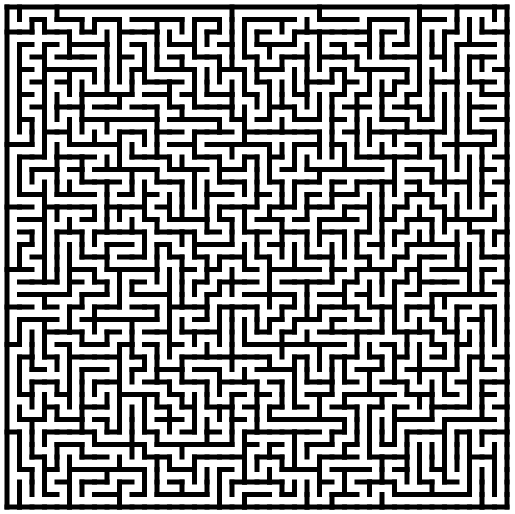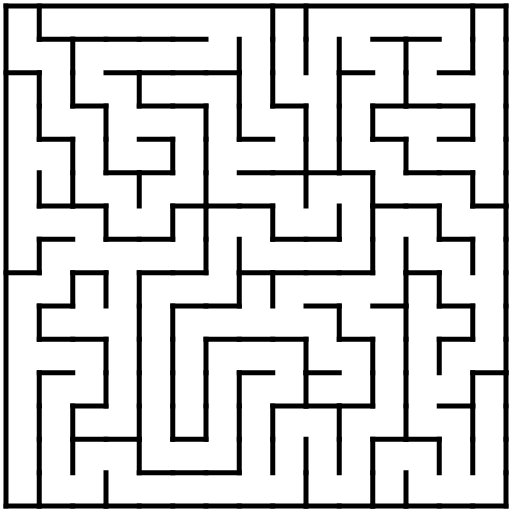Making a maze
Posted on 13 April 2017
The Depth-first search algorithm is a simple approach to generating a maze. It is well described and illustrated in lots of places on the internet, so only an outline is given here.
The maze is considered to consist of a grid of cells; each cell initially has four walls (North, East, South and West). Starting from a given cell, we will aim to produce a path visiting each cell according to the following procedure:
- Inspect the neighbouring cells. If any of them have yet to be visited, pick one and move at random into it by removing the wall between them.
- If no neighbouring cell is unvisited (a dead end), then backtrack to the last cell with an unvisited neighbour.
In the implemention of this algorithm in the Python program below, we define classes for the cell and for the entire maze. We wind our way through the grid of cells at random, keeping track of the path we take on a stack implemented as a Python list. If we end up in a dead end, we simply pop visited cells off the stack until we find one with unvisited neighbours.
The code below produces an SVG image of a maze with given dimensions. For example (40 x 40):

and (15 x 15):

This code is also available on my Github page.
# df_maze.py
import random
# Create a maze using the depth-first algorithm described at
# https://scipython.com/blog/making-a-maze/
# Christian Hill, April 2017.
class Cell:
"""A cell in the maze.
A maze "Cell" is a point in the grid which may be surrounded by walls to
the north, east, south or west.
"""
# A wall separates a pair of cells in the N-S or W-E directions.
wall_pairs = {'N': 'S', 'S': 'N', 'E': 'W', 'W': 'E'}
def __init__(self, x, y):
"""Initialize the cell at (x,y). At first it is surrounded by walls."""
self.x, self.y = x, y
self.walls = {'N': True, 'S': True, 'E': True, 'W': True}
def has_all_walls(self):
"""Does this cell still have all its walls?"""
return all(self.walls.values())
def knock_down_wall(self, other, wall):
"""Knock down the wall between cells self and other."""
self.walls[wall] = False
other.walls[Cell.wall_pairs[wall]] = False
class Maze:
"""A Maze, represented as a grid of cells."""
def __init__(self, nx, ny, ix=0, iy=0):
"""Initialize the maze grid.
The maze consists of nx x ny cells and will be constructed starting
at the cell indexed at (ix, iy).
"""
self.nx, self.ny = nx, ny
self.ix, self.iy = ix, iy
self.maze_map = [[Cell(x, y) for y in range(ny)] for x in range(nx)]
def cell_at(self, x, y):
"""Return the Cell object at (x,y)."""
return self.maze_map[x][y]
def __str__(self):
"""Return a (crude) string representation of the maze."""
maze_rows = ['-' * self.nx * 2]
for y in range(self.ny):
maze_row = ['|']
for x in range(self.nx):
if self.maze_map[x][y].walls['E']:
maze_row.append(' |')
else:
maze_row.append(' ')
maze_rows.append(''.join(maze_row))
maze_row = ['|']
for x in range(self.nx):
if self.maze_map[x][y].walls['S']:
maze_row.append('-+')
else:
maze_row.append(' +')
maze_rows.append(''.join(maze_row))
return '\n'.join(maze_rows)
def write_svg(self, filename):
"""Write an SVG image of the maze to filename."""
aspect_ratio = self.nx / self.ny
# Pad the maze all around by this amount.
padding = 10
# Height and width of the maze image (excluding padding), in pixels
height = 500
width = int(height * aspect_ratio)
# Scaling factors mapping maze coordinates to image coordinates
scy, scx = height / self.ny, width / self.nx
def write_wall(ww_f, ww_x1, ww_y1, ww_x2, ww_y2):
"""Write a single wall to the SVG image file handle f."""
print('<line x1="{}" y1="{}" x2="{}" y2="{}"/>'
.format(ww_x1, ww_y1, ww_x2, ww_y2), file=ww_f)
# Write the SVG image file for maze
with open(filename, 'w') as f:
# SVG preamble and styles.
print('<?xml version="1.0" encoding="utf-8"?>', file=f)
print('<svg xmlns="http://www.w3.org/2000/svg"', file=f)
print(' xmlns:xlink="http://www.w3.org/1999/xlink"', file=f)
print(' width="{:d}" height="{:d}" viewBox="{} {} {} {}">'
.format(width + 2 * padding, height + 2 * padding,
-padding, -padding, width + 2 * padding, height + 2 * padding),
file=f)
print('<defs>\n<style type="text/css"><![CDATA[', file=f)
print('line {', file=f)
print(' stroke: #000000;\n stroke-linecap: square;', file=f)
print(' stroke-width: 5;\n}', file=f)
print(']]></style>\n</defs>', file=f)
# Draw the "South" and "East" walls of each cell, if present (these
# are the "North" and "West" walls of a neighbouring cell in
# general, of course).
for x in range(self.nx):
for y in range(self.ny):
if self.cell_at(x, y).walls['S']:
x1, y1, x2, y2 = x * scx, (y + 1) * scy, (x + 1) * scx, (y + 1) * scy
write_wall(f, x1, y1, x2, y2)
if self.cell_at(x, y).walls['E']:
x1, y1, x2, y2 = (x + 1) * scx, y * scy, (x + 1) * scx, (y + 1) * scy
write_wall(f, x1, y1, x2, y2)
# Draw the North and West maze border, which won't have been drawn
# by the procedure above.
print('<line x1="0" y1="0" x2="{}" y2="0"/>'.format(width), file=f)
print('<line x1="0" y1="0" x2="0" y2="{}"/>'.format(height), file=f)
print('</svg>', file=f)
def find_valid_neighbours(self, cell):
"""Return a list of unvisited neighbours to cell."""
delta = [('W', (-1, 0)),
('E', (1, 0)),
('S', (0, 1)),
('N', (0, -1))]
neighbours = []
for direction, (dx, dy) in delta:
x2, y2 = cell.x + dx, cell.y + dy
if (0 <= x2 < self.nx) and (0 <= y2 < self.ny):
neighbour = self.cell_at(x2, y2)
if neighbour.has_all_walls():
neighbours.append((direction, neighbour))
return neighbours
def make_maze(self):
# Total number of cells.
n = self.nx * self.ny
cell_stack = []
current_cell = self.cell_at(self.ix, self.iy)
# Total number of visited cells during maze construction.
nv = 1
while nv < n:
neighbours = self.find_valid_neighbours(current_cell)
if not neighbours:
# We've reached a dead end: backtrack.
current_cell = cell_stack.pop()
continue
# Choose a random neighbouring cell and move to it.
direction, next_cell = random.choice(neighbours)
current_cell.knock_down_wall(next_cell, direction)
cell_stack.append(current_cell)
current_cell = next_cell
nv += 1
To use this class, run a script such as the following:
from df_maze import Maze
# Maze dimensions (ncols, nrows)
nx, ny = 15, 15
# Maze entry position
ix, iy = 0, 0
maze = Maze(nx, ny, ix, iy)
maze.make_maze()
print(maze)
maze.write_svg('maze.svg')